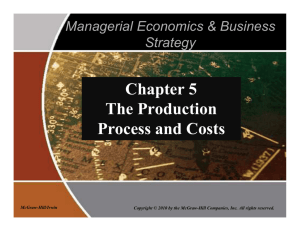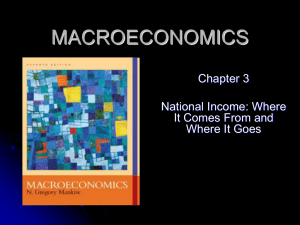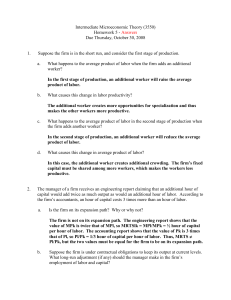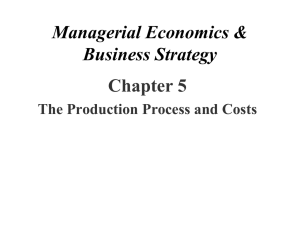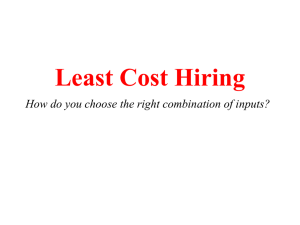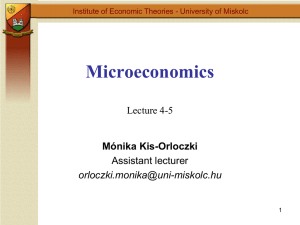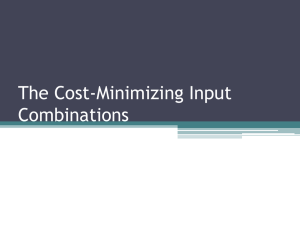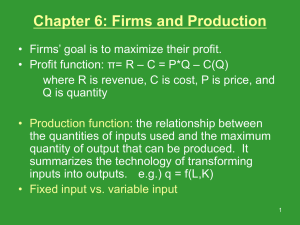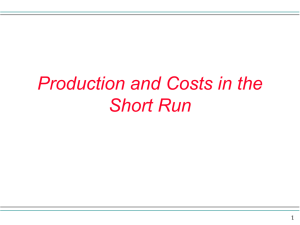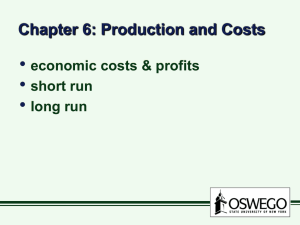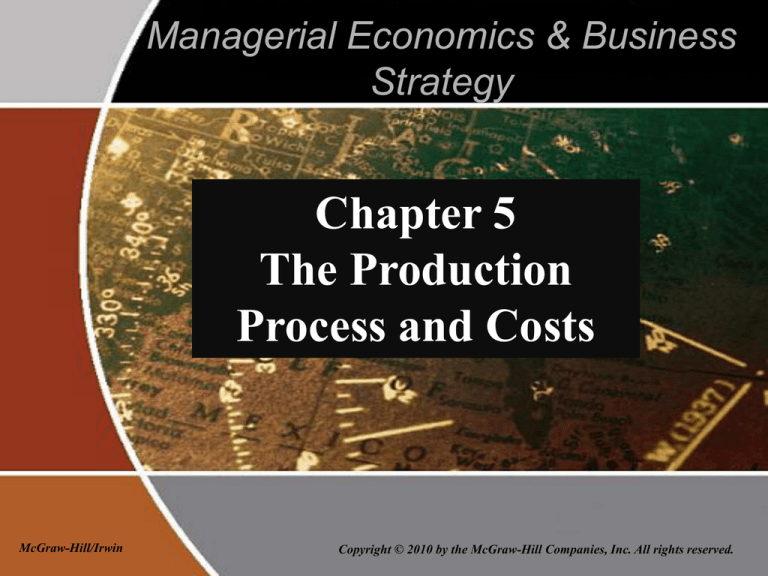
Managerial Economics & Business
Strategy
Chapter 5
The Production
Process and Costs
McGraw-Hill/Irwin
Copyright © 2010 by the McGraw-Hill Companies, Inc. All rights reserved.
Overview
I. Production Analysis
–
–
–
–
Total Product, Marginal Product, Average Product.
Isoquants.
Isocosts.
Cost Minimization
II. Cost Analysis
– Total Cost, Variable Cost, Fixed Costs.
– Cubic Cost Function.
– Cost Relations.
III. Multi-Product Cost Functions
5-2
Production Theory
Production theory serves as the basis for
other business disciplines such as human
resources, operations management,
managerial accounting, and strategic
management.
Successful businesses use an optimal
amount and mix of production factors as
factor and output markets change.
5-3
Production Analysis
Technology – engineering know-how
Production Function
– Q = F(K,L)
• Q is quantity of output produced.
• K is capital input.
• L is labor input.
• F is a functional form relating the inputs to output.
– The maximum amount of output that can be produced
with K units of capital and L units of labor.
– Manager’s responsibility – use the production
function efficiently – how much of each input to use,
5-4
SR and LR
Short-Run vs. Long-Run Decisions – in the SR some
factors are fixed limiting input choice decisions.
The mix of variable factors can be changed in the SR.
In the LR is the production horizon in which all
factors are variable.
In the simple two factor case if K is fixed in the SR then
the only use decisions apply to L.
Q = f(L) = F(K*,L)
5-5
Production Function Algebraic Forms
Linear production function: inputs are
perfect substitutes.
Q F K , L aK bL
Where a and b are constants.
If capital is 5 times more productive than labor
then the function becomes:
Q = 5K + L
If F(8,3) then 5(8) + 1(3), then Q = 43
Linear production functions do not obey the law of
DMR
5-6
Linear Isoquants
Capital and labor
are perfect
substitutes
– Q = aK + bL
– MRTSKL = b/a
– Linear isoquants imply
that inputs are
substituted at a constant
rate, independent of the
input levels employed.
K
Increasing
Output
Q1
Q2
Q3
L
5-7
Production Function Algebraic Forms
Leontief production function:
inputs are used in fixed proportions –
a fixed proportion of K to L for output to
increase.
Q F K , L minbK, cL
5-8
Leontief Isoquants
Capital and labor are
K
perfect complements.
Capital and labor are used
in fixed-proportions.
Q = min {bK, cL}
Since capital and labor are
consumed in fixed
proportions there is no
input substitution along
isoquants (hence, no
MRTSKL).
Q3
Q2
Q1
Increasing
Output
L
5-9
Production Function Algebraic Forms
Cobb-Douglas production
function: inputs have a
degree of substitutability.
Q F K , L K a Lb
Here the relationship between
output and inputs is not linear.
5-10
Cobb-Douglas Isoquants
Inputs are not perfectly
substitutable.
Diminishing marginal
rate of technical
substitution.
K
Q3
Q2
Q1
Increasing
Output
– As less of one input is used
in the production process,
increasingly more of the
other input must be
employed to produce the
same output level.
Q = KaLb
MRTSKL = MPL/MPK
L
5-11
Productivity Measures:
Total Product
Total Product (TP): maximum output produced
with given amounts of inputs.
Example: Cobb-Douglas Production Function:
Q = F(K,L) = K.5 L.5
– K is fixed at 16 units.
– Short run Cobb-Douglass production function:
Q = (16).5 L.5 = 4 L.5
– Total Product when 100 units of labor are used?
Q = 4 (100).5 = 4(10) = 40 units
5-12
Productivity Measures:
Average Product of an Input
Average Product of an Input: measure of
output produced per unit of input.
– Average Product of Labor: APL = Q/L.
• Measures the output of an “average” worker.
• Example: Q = F(K,L) = K.5 L.5
If the inputs are K = 16 and L = 16, then the
average product of labor is
APL = [(16) 0.5(16)0.5]/16 = 1.
5-13
Productivity Measures:
Average Product of an Input
– Average Product of Capital: APK = Q/K.
• Measures the output of an “average” unit of capital.
• Example: Q = F(K,L) = K.5 L.5
If the inputs are K = 16 and L = 16, then the
average product of capital is
APK = [(16)0.5(16)0.5]/16 = 1.
5-14
Productivity Measures: Marginal Product
of an Input
Marginal Product of an Input: change in
total output attributable to the last unit of an
input.
– Marginal Product of Labor: MPL = DQ/DL
• Measures the output produced by the last
worker.
• Slope of the short-run production function (with
respect to labor).
5-15
Productivity Measures: Marginal
Product of an Input
– Marginal Product of Capital: MPK = DQ/DK
• Measures the output produced by the last unit of
capital.
• When capital is allowed to vary in the short run,
MPK is the slope of the production function (with
respect to capital).
5-16
Guiding the Production Process
Producing on the production function
Most difficult to achieve
– Aligning incentives to induce maximum worker
effort.
Employing the right level of inputs
– When labor or capital vary in the short run, to
maximize profit a manager will hire:
• labor until the value of marginal product of labor equals
the wage: VMPL = w, where VMPL = P x MPL.
• capital until the value of marginal product of capital
equals the rental rate: VMPK = r, where VMPK = P x
MPK .
5-17
Marginal Product of an Input in a CobbDouglas Production Function
Q = F(K,L) = KaLb
then MPL = bKaLb-1
and MPK = aKa-1Lb
See page 167 for demonstration problem.
5-18
Increasing, Diminishing and
Negative Marginal Returns
Q
Increasing
Marginal
Returns
Diminishing
Marginal
Returns
Negative
Marginal
Returns
Q=F(K,L)
MP
AP
L
5-19
Isoquants
Assume management flexibility in the
production process.
Illustrates the long-run combinations of inputs
(K, L) that yield the producer the same level
of output.
The shape of an isoquant reflects the ease
with which a producer can substitute among
inputs while maintaining the same level of
output.
5-20
Cobb-Douglas Isoquants
Inputs are not perfectly
substitutable.
Diminishing marginal
rate of technical
substitution.
K
Q3
Q2
Q1
Increasing
Output
– As less of one input is used
in the production process,
increasingly more of the
other input must be
employed to produce the
same output level.
Q = KaLb
MRTSKL = MPL/MPK
L
5-21
Marginal Rate of Technical Substitution
(MRTS)
The rate at which two inputs are substituted
while maintaining the same output level.
The manager must determine the efficient
combination of resource use to max profits.
MRTSKL
MPL
MPK
5-22
Isocost
The combinations of inputs
K
that produce a given level of
C1/r
output at the same cost:
C0/r
wL + rK = C
Rearranging,
K= (1/r)C - (w/r)L
For given input prices,
K
isocosts farther from the
C/r
origin are associated with
higher costs.
Changes in input prices
change the slope of the
isocost line.
New Isocost Line
associated with higher
costs (C0 < C1).
C0
C0/w
C1
C1/w
L
New Isocost Line for
a decrease in the
wage (price of labor:
w0 > w1).
C/w0
C/w1
L
5-23
Cost Minimization
Marginal product per dollar spent should be
equal for all inputs (Equi-marginal rule):
MPL MPK
MPL w
w
r
MPK r
But, this is just
MRTS KL
w
r
So equilibrium for the producer is the point where the
slope of the isoquant = slope of the isocost.
5-24
Equi-Marginal Rule Example
Suppose Ford uses 10 workers and 10 robots to produce one
automobile. Suppose also the MPL = 10 cars/day and the MPK = 10
cars/day. If the wage = $40/hr and the cost of the robots is $100/hr is
Ford using these two inputs in a cost-minimizing manner?
C = 10($40) + 10($100) = $1400
MPL/PL = MPK/PK
10/40 is not equal to 10/100
.25 > .10
Increase the number of workers to 12 so that the MPL decreases to 8
(ratio = .20), decrease the number of robots to 8 to increase the MPK
to 20 (ratio = .20)
8/40 = 20/100
C = 12($40) + 8($100) = $1280
5-25
Cost Minimization
K
Slope of Isocost
=
Slope of Isoquant
Point of Cost
Minimization
Q
L
5-26
Optimal Input Substitution
A firm initially produces Q0
by employing the
combination of inputs
represented by point A at a
cost of C0.
Suppose w0 falls to w1.
– The isocost curve rotates
counterclockwise; which
represents the same cost
level prior to the wage
change.
– To produce the same level of
output, Q0, the firm will
produce on a lower isocost
line (C1) at a point B.
– The slope of the new isocost
line represents the lower
wage relative to the rental
rate of capital.
K
A
K0
B
K1
Q0
0 L0
L1 C0/w0
C1/w1
C0/w1 L
5-27
Cost Analysis
Types of Costs
– Short-Run
• Fixed costs (FC)
• Sunk costs
• Short-run variable
costs (VC)
• Short-run total costs
(TC)
– Long-Run
• All costs are
variable
• No fixed costs
5-28
Cost Function
The cost function provides the manager
essential information needed to determine
the profit maximizing level of output.
Summarizes the information about the
production process.
5-29
Total and Variable Costs
C(Q): Minimum total cost of $
producing alternative levels
of output:
C(Q) = VC + FC
C(Q) = VC(Q) + FC
VC(Q)
VC(Q): Costs that vary with
output.
FC: Costs that do not vary
with output.
FC
0
Q
5-30
Fixed and Sunk Costs
FC: Costs that do not
change as output changes.
Sunk Cost: A cost that is
forever lost after it has been
paid.
The amount of fixed costs
that cannot be recouped.
Decision makers should
ignore sunk costs to
maximize profit or minimize
losses
$
C(Q) = VC + FC
VC(Q)
FC
Q
5-31
Some Definitions
Average Total Cost
ATC = AVC + AFC
ATC = C(Q)/Q
$
MC
ATC
AVC
Average Variable Cost
AVC = VC(Q)/Q
Average Fixed Cost
AFC = FC/Q
Marginal Cost
MC = DC/DQ
MR
AFC
Q 5-32
Fixed Cost
Q0(ATC-AVC)
$
= Q0 AFC
= Q0(FC/ Q0)
MC
ATC
AVC
= FC
ATC
AFC
Fixed Cost
AVC
Q0
Q
5-33
Variable Cost
$
Q0AVC
MC
ATC
= Q0[VC(Q0)/ Q0]
AVC
= VC(Q0)
AVC
Variable Cost
Minimum of AVC
Q0
Q
5-34
Total Cost
Q0ATC
$
= Q0[C(Q0)/ Q0]
= C(Q0)
MC
ATC
AVC
ATC
Minimum of ATC
Total Cost
Q0
Q
5-35
Cubic Cost Function
C(Q) = f + a Q + b Q2 + cQ3
Marginal Cost?
– Memorize:
MC(Q) = a + 2bQ + 3cQ2
– Calculus:
dC/dQ = a + 2bQ + 3cQ2
5-36
An Example
– Total Cost: C(Q) = 10 + Q + Q2
– Variable cost function:
VC(Q) = Q + Q2
– Variable cost of producing 2 units:
VC(2) = 2 + (2)2 = 6
– Fixed costs:
FC = 10
– Marginal cost function:
MC(Q) = 1 + 2Q
– Marginal cost of producing 2 units:
MC(2) = 1 + 2(2) = 5
5-37
Another Example
C(Q) = 45 + 6Q + 12Q2
Suppose Q = 20
MC = 6 + 24Q
AFC = 45/20 = 2.25
AVC = 6Q + 12Q2 /Q = 6 + 12Q = 246
ATC = 45 + 6Q + 12Q2/Q =
45/Q + 6 +12Q= 248.25
5-38
LRAC Function
The LRAC function is the envelope of all
possible SRATC functions.
As output expands the firm must adjust its
scale to be sure it is operating at least
cost.
5-39
Long-Run Average Costs
$
LRAC
Economies
of Scale
Diseconomies
of Scale
Q*
Q
5-40
Multi-Product Cost Function – Economies of Scope
and Cost Complementarities
C(Q1, Q2): Cost of jointly producing two outputs.
General functional form:
CQ1, Q2 f aQ1Q2 bQ12 cQ22
MC1 = aQ2 + 2bQ1
MC2 = aQ1 + 2cQ2
If a > 0 then there are no cost complementarities in production.
If a < 0 then there are cost complementarities.
5-41
Economies of Scope
C(Q1, 0) + C(0, Q2) > C(Q1, Q2).
– It is cheaper to produce the two outputs jointly
instead of separately.
Example:
– It is cheaper for Time-Warner to produce
Internet connections and Instant Messaging
services jointly than separately.
– Dunkin Donuts
5-42
Cost Complementarity
The marginal cost of producing good 1
declines as more of good two is produced:
DMC1Q1,Q2) /DQ2 < 0.
Example:
– Cow hides and steaks.
5-43
Quadratic Multi-Product Cost
Function
C(Q1, Q2) = f + aQ1Q2 + (Q1 )2 + (Q2 )2
MC1(Q1, Q2) = aQ2 + 2Q1
MC2(Q1, Q2) = aQ1 + 2Q2
Cost complementarity:
a<0
Economies of scope:
f > aQ1Q2
C(Q1 ,0) + C(0, Q2 ) = f + (Q1 )2 + f + (Q2)2
C(Q1, Q2) = f + aQ1Q2 + (Q1 )2 + (Q2 )2
f > aQ1Q2: Joint production is cheaper
5-44
A Numerical Example:
C(Q1, Q2) = 90 - 2Q1Q2 + (Q1 )2 + (Q2 )2
Cost Complementarity?
Yes, since a = -2 < 0
MC1(Q1, Q2) = -2Q2 + 2Q1
Economies of Scope?
Yes, since 90 > -2Q1Q2
Example pg 189.
5-45
Conclusion
To maximize profits (minimize costs)
managers must use inputs such that the
value of marginal product of each input
reflects price the firm must pay to employ the
input.
The optimal mix of inputs is achieved when
the MRTSKL = (w/r).
Cost functions are the foundation for helping
to determine profit-maximizing behavior in
future chapters.
5-46

